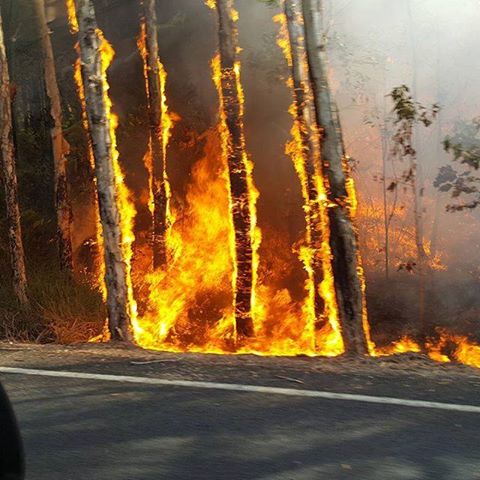NSW RURAL Fire Service were called to a fire that broke out at Clothiers Creek Road near the Pacific Motorway at 11.30am on Wednesday, December 28.
Fire Service Inspector Angela Daly told The Weekly four units were need to contain the four hectare fire over a period of eight hours.
“Crews were also called back to the site today (Thursday, December 29) after some smoke was seen in the area again,” Inspector Daly said.
“We have now contained the fire in the area.”
The fire was around the same location as a previous fire which was believed to be deliberately lit. Inspector Daly said the cause of the fire was unknown.
“The cause of the fire is undetermined at this stage,” she said.
NSW Rural Fire Service Far North Coast Team have also issued a continued fire ban across the Northern Rivers.
“Issuing of fire permits remains suspended until further notice, across Far North Coast (Ballina, Byron and Tweed shires), due to ongoing dry conditions,” a social media post reads.
“Conditions will continue to be monitored on a daily basis.”
Meanwhile, the Northern NSW Local Health District has issued a heat wave warning urging residents to take precautions in the scorching 3-degree-plus temperatures.
As an additional precaution, businesses and commercial buildings’ management may also need to inspect their existing fire safety mechanisms in order to reduce damage caused by a fire. In order for management to ensure the efficacy of the fire safety plan, they might need a proper fire extinguishers check by Asset Test & Tag Adelaide (or another similar company nearby), maintain the fire exits, and repair hose pipes.
“A prolonged period of hot, humid northerly winds will bring severe heatwave conditions to parts of NSW mainly from the Great Divide to the coast this week, with extreme heatwave conditions developing along the north and mid-north coasts” said Bureau of Meteorology Acting NSW Regional Director, Stephen Lellyett in a media release.
“Many centres east of the Divide, particularly in the north coast area, will see overnight temperatures above 20 degrees with daytime maximums above 35 degrees through to the end of the weekend. A slow moving cool change approaching southwest NSW on Thursday is not expected to clear the NSW north coast until next Monday,” Mr Lellyett said.
North Coast Public Health Director, Paul Corben, said “With severe and extreme heatwave conditions forecast it is important that people take precautions to prevent heat-related illness.
“Heat-related illness ranges from mild conditions to very serious medical emergencies,” Mr Corben said.
“While heat-related illness can affect anyone, certain groups of people are particularly vulnerable.
“These include older people, infants and children, people with a chronic medical condition and those who live alone.
“During hot weather, it’s important to stay in regular contact with elderly neighbours, friends and relatives and to look out for other vulnerable members of their community.
“Heat puts a lot of strain on the body and can cause dehydration, heat exhaustion and heat stroke. It can also make underlying health conditions worse.
“Being prepared and taking simple precautions reduces the risk of heat-related illness.”
Mr Corben said the following simple precautions will help minimise the risk of heat-related illness.
- Drink plenty of water, and remember to carry some with you when out and about.
- Avoid alcoholic, hot or sugary drinks.
- Plan your day around the heat, particularly in the middle of the day, and minimise physical activity.
- Keep the sun out by shading windows with curtains, blinds or closing shutters.
- Keep windows closed during the day until it cools down and in early morning.
- If you don’t have an air-conditioner, try to invest in one (see different types of air conditioners here). If you can’t afford it, then spend time in an air-conditioned place like a shopping centre, library or cinema.
- Wear light, loose-fitting clothing made from natural fibres like cotton.
- When outdoors, stay protected from the sun by wearing a hat and sunscreen.
“Signs of heat-related illness may include nausea, vomiting, faintness and dizziness, loss of appetite, weakness, headaches, loss of sweating and reduced urine output,” Mr Corben said.
“People showing severe signs of heat-related illness should seek urgent medical attention through their GP or the emergency department at their nearest hospital.
“And it is absolutely essential children and pets are not left in cars. They will become distressed and seriously ill in a matter of minutes.
More information about heat-health, including downloadable advice in several languages, can be found on the NSW Health website ‘Beat the Heat’:
www.health.nsw.gov.au/environment/beattheheat
Bureau of Meteorology heatwave forecasts are available at: http://www.bom.gov.au/australia/heatwave/
Temperature forecasts are available at: http://www.bom.gov.au/australia/meteye/
